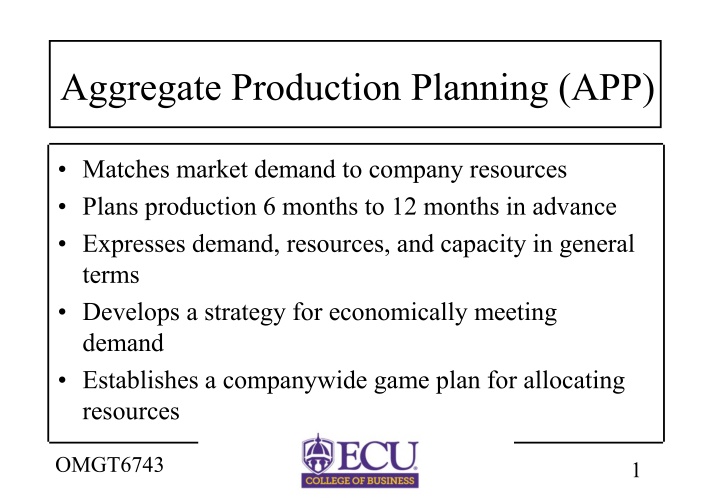
Advanced Strategies for Aggregate Production Planning
Learn how Aggregate Production Planning (APP) aligns market demand with company resources through strategic planning, capacity management, and resource allocation. Discover various strategies for meeting demand, such as level production, chasing demand, subcontracting, and utilizing part-time workers. Explore the nuances of each strategy and their implications on production efficiency and customer service levels.
Download Presentation

Please find below an Image/Link to download the presentation.
The content on the website is provided AS IS for your information and personal use only. It may not be sold, licensed, or shared on other websites without obtaining consent from the author. If you encounter any issues during the download, it is possible that the publisher has removed the file from their server.
You are allowed to download the files provided on this website for personal or commercial use, subject to the condition that they are used lawfully. All files are the property of their respective owners.
The content on the website is provided AS IS for your information and personal use only. It may not be sold, licensed, or shared on other websites without obtaining consent from the author.
E N D
Presentation Transcript
Aggregate Production Planning (APP) Matches market demand to company resources Plans production 6 months to 12 months in advance Expresses demand, resources, and capacity in general terms Develops a strategy for economically meeting demand Establishes a companywide game plan for allocating resources OMGT6743 1
Inputs and Outputs to Aggregate Production Planning Strategic Objectives Constraints Capacity Company Policies Demand Forecasts Financial Constraints Aggregate Production Planning Size of Workforce Units or dollars subcontracted, backordered, or lost Production per month (in units or $) Inventory Levels OMGT6743 2
Strategies for Meeting Demand 1. Use inventory to absorb fluctuations in demand (level production) 2. Hire and fire workers to match demand (chase demand) 3. Maintain resources for high demand levels 4. Increase or decrease working hours (over & undertime) 5. Subcontract work to other firms 6. Use part-time workers 7. Provide the service or product at a later time period (backordering) OMGT6743 3
Strategy Details Level production - produce at constant rate & use inventory as needed to meet demand Chase demand - change workforce levels so that production matches demand Maintaining resources for high demand levels - ensures high levels of customer service Overtime & undertime - common when demand fluctuations are not extreme OMGT6743 4
Strategy Details Subcontracting - useful if supplier meets quality & time requirements Part-time workers - feasible for unskilled jobs or if labor pool exists Backordering - only works if customer is willing to wait for product/services OMGT6743 5
Level Production Demand Production Units Time OMGT6743 6
Chase Demand Demand Units Production Time OMGT6743 7
APP Using Pure Strategies Quarter Spring Summer Fall Winter Sales Forecast (lb) 80,000 50,000 120,000 150,000 Hiring cost = $100 per worker Firing cost = $500 per worker Inventory carrying cost = $0.50 pound per quarter Production per employee = 1,000 pounds per quarter Beginning work force = 100 workers OMGT6743 8
Level Production Strategy Quarter Spring Summer Fall Winter Sales Forecast 80,000 50,000 120,000 150,000 400,000 Production Plan 100,000 100,000 100,000 100,000 Inventory 20,000 70,000 50,000 0 140,000 Cost = 140,000 pounds x 0.50 per pound = $70,000 OMGT6743 9
Chase Demand Strategy Quarter Spring Summer Fall Winter Sales Forecast 80,000 50,000 120,000 150,000 Production Plan 80,000 50,000 120,000 150,000 Workers Needed 80 50 120 150 Workers Hired - - 70 30 100 Workers Fired 20 30 - - 50 Cost = (100 workers hired x $100) + (50 workers fired x $500) = $10,000 + 25,000 = $35,000 OMGT6743 10
Other Quantitative Techniques Linear programming Linear decision rule (LDR) Search decision rule (SDR) Management coefficients model OMGT6743 11
Strategies for Managing Demand Shift demand into other periods incentives, sales promotions, advertising campaigns Offer product or services with countercyclical demand patterns create demand for idle resources OMGT6743 12
Hierarchical Planning Process Items Product lines or families Production Planning Aggregate Production Plan Capacity Planning Resource Requirements Plan Resource level Plants Individual products Critical work centers Master Production Schedule Rough-Cut Capacity Plan All work centers Material Capacity Requirements Plan Components Requirements Plan Manufacturing operations Individual machines Shop Floor Schedule Input/Output Control OMGT6743 13
Aggregate Planning for Services 1. Most services can t be inventoried 2. Demand for services is difficult to predict 3. Capacity is also difficult to predict 4. Service capacity must be provided at the appropriate place and time 5. Labor is usually the most constraining resource for services OMGT6743 14
